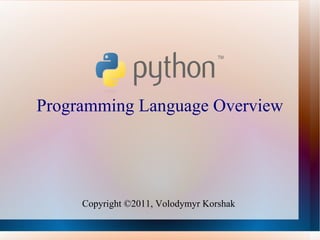Python Language Overview: History, Philosophy, Usage & Features
•Download as PPT, PDF•
2 likes•467 views
CMPE202-01 Research project. SJSU 2011
Report
Share
Report
Share

Recommended
More Related Content
What's hot
What's hot (19)
Learn Python Programming | Python Programming - Step by Step | Python for Beg...

Learn Python Programming | Python Programming - Step by Step | Python for Beg...
Introduction to python programming, Why Python?, Applications of Python

Introduction to python programming, Why Python?, Applications of Python
Similar to Python Language Overview: History, Philosophy, Usage & Features
Similar to Python Language Overview: History, Philosophy, Usage & Features (20)
Python Programming Unit1_Aditya College of Engg & Tech

Python Programming Unit1_Aditya College of Engg & Tech
Python_final_print_batch_II_vision_academy (1).pdf

Python_final_print_batch_II_vision_academy (1).pdf
Training report 1923-b.e-eee-batchno--intern-54 (1).pdf

Training report 1923-b.e-eee-batchno--intern-54 (1).pdf
Python Language Overview: History, Philosophy, Usage & Features
- 1. Programming Language Overview Copyright ©2011, Volodymyr Korshak
- 5. Programming Philosophy
- 10. Code Samples
- 18. Where is it used?
- 23. Features
- 28. Summary
Editor's Notes
- Python 2.0 was released on 16 October 2000, with many major new features including a full garbage collector and support for Unicode.